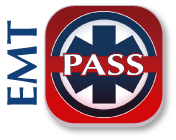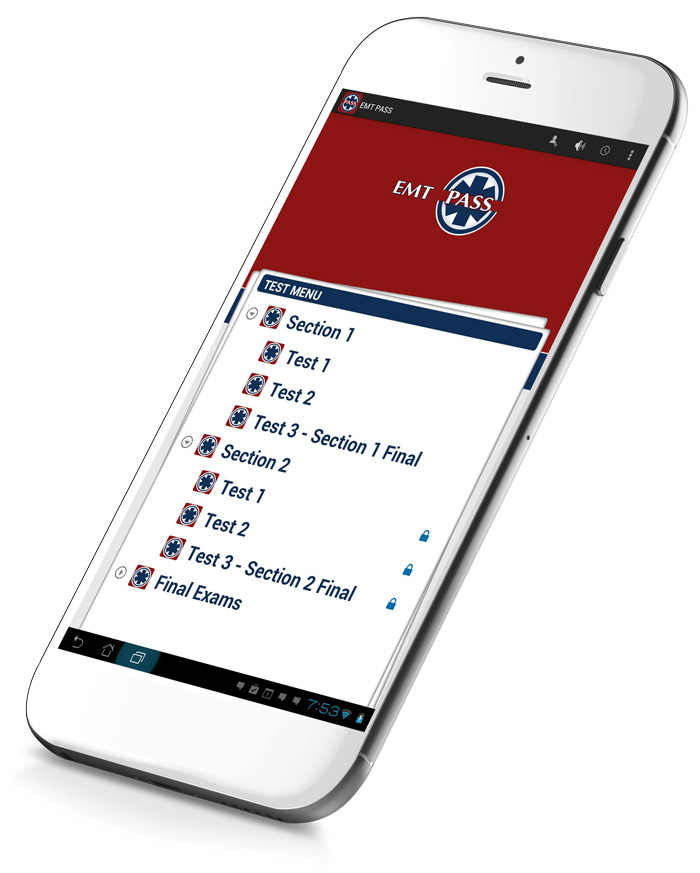![]()
 EMT PASS was designed for two reasons:
EMT PASS was designed for two reasons:
1) to be part of classroom learning and
2) as a self-assessment application.
Because the test items correlate to an EMT course, the first two tests and the third summative “summary” examination should be used after the first half of the course has been completed.
The exams match the topical sequence prescribed in the National EMS Education Standards for EMT education. When presented, the items will be “mixed up” so that the first items on the exam will not be over the first chapter in a textbook or via the first topics in the Education Standards. However, the first three tests will not include items that have not yet been covered (latter chapters of a text or topics within the Education Standards.)
Tests 1 through 3 cover only EMT knowledge regarding:
Preparatory Information
- EMS Systems
- Research
- Workforce Safety and Wellness
- Documentation
- EMS Systems Communication
- Therapeutic Communication
- Medical/Legal and Ethics
Anatomy and Physiology
Medical Terminology
Pathophysiology
Life Span Development
Public Health
Pharmacology
- Principles of Pharmacology
- Medication Administration
- Emergency Medications
Airway Management, Respiration and Artificial Ventilation
- Airway Management
- Respiration
- Artificial Ventilation
Assessment
- Scene Size-Up
- Primary Assessment
- History Taking
- Secondary Assessment
- Monitoring Devices
- Reassessment
Medicine
- Medical Overview
- Neurology
- Abdominal and Gastrointestinal Diseases
- Immunology
- Infectious Diseases
- Endocrine Disorders
- Psychiatric
- Cardiovascular
- Toxicology
- Respiratory
- Hematology
- Genitourinary/Renal
- Gynecology
- Non-Traumatic Musculoskeletal Disorders
- Disease of the Eyes, Ears, Nose and Throat
Tests 1 and 2 contain audio debriefings.
Tests 4 through 6 cover only EMT knowledge regarding the following topics:
Trauma
- Trauma Overview
- Bleeding
- Chest Trauma
- Abdominal and Genitourinary Trauma
- Orthopedic Trauma
- Soft Tissue Trauma
- Head, Facial, Neck and Spine Trauma
- Nervous System Trauma
- Special Considerations in Trauma
- Environmental Emergencies
- Multi-System Trauma
Special Patient Populations
- Obstetrics
- Neonatal Care
- Pediatrics
- Geriatrics
- Patients with Special Challenges
EMS Operations
- Principles of Safety, Operating a Ground Ambulance
- Incident Management
- Multiple Causality Incidents
- Air Medical
- Vehicle Extrication
- Hazardous Materials Awareness
- Mass Causality Incidents due to Terrorism and Disaster
Tests 4 and 5 have audio debriefings.
The sixth test is another exam that covers the second half of the course.
Tests 7 and 8 are “summative examinations” that cover the entire content of EMT knowledge. They are simulation examinations and do not have audio debriefings but have “meaningful” result scores.
The above represents a great deal of content, which is why there are 960 questions in the application.
EMT PASS is very comprehensive, with questions written via this content, and cover anatomy and physiology/pathophysiology, assessment findings, and management related to the topic.
No other EMT self-assessment textbook or application gives feedback regarding “how you did on a test.
What is a “meaningful score”?
With EMT PASS, you get a meaningful score. A percentage score, which is used by other applications, is often meaningless and does not help the student improve. EMT PASS does not just provide a percentage of questions you got correct (percentage score). For example, a test in which 50% of the questions answered correctly could be considered an outstanding score. Likewise a test could be developed that was so easy that if you got 85% of the items correct it would be a poor or failing score. This doesn’t seem right or make sense, but there are tests available that do just that! The “difficulty” of a test is dependent upon answering the question, “How difficult were the test questions?” When taking a “very difficult” test, it is possible to miss more questions and still pass. An easy test requires a very high score and has a disadvantage for poor readers.
Self-assessment means a person using the application will receive feedback regarding how he/she did on the test.

“How you do on a test” goes beyond which questions you got correct or incorrect. In order to know how a person performed on a test the questions have to be calibrated in some manner. This is a very difficult and involved process, but to make it as easy as possible to understand, it involves a mix of easy, moderate and difficult items within every test that are calibrated “ranges” of scores. As a result, these provide guidance in answering the question, “How did I do on that test?”
EMT PASS has the proper mix of difficult, moderate and easy questions so that the outcome will be meaningful!
If a Certification candidate has completed the entire EMT Course, the sequence of the tests will not be important to him/her. All 8 tests can be covered sequentially. It is unlikely these tests can be covered in a short period of time.
Self-assessment means a person using the application will receive feedback regarding how he/she did on the test. “How you do on a test” goes beyond which questions you got correct or incorrect. In order to know how a person performed on a test the questions have to be calibrated in some manner. This is a very difficult and involved process, but to make it as easy as possible to understand, it involves a mix of easy, moderate and difficult items within every test that are calibrated “ranges” of scores. The range of scores will help predict how well you will do on the NREMT exam.
Self-assessment is not about promoting a sense of false confidence. The questions could have been written so that students could easily pass every test, and think they were knowledgeable about every subject and ready for certification. Self-assessment involves a test that assesses whether you know—or can figure out—how to correctly answer enough calibrated questions to pass a test. An “error in measurement” has to be used. In the case of EMT Pass, the error range was used to develop five categories or ranges that test takers can fall into:
- Range One—outstanding
- Range Two—good
- Range Three—borderline/passing
- Range Four—borderline/failing
- Range Five—need for a great deal of improvement
Students will fall within one of these categories and will receive a briefing about their outcome.
Summary
A test preparation book or application can be purchased that might seem like a “good deal” because it “didn’t cost a lot,” it was “affordable,” or it made a lot of claims that sounded good. If the book or application only gives a percent (%) score on each test, however, it isn’t adequately preparing the student to take the exam. As a result, the student may fail the exam, requiring him or her to take it again…and maybe again…which means the book or application was actually a “good deal” after all!
EMT PASS, on the other hand, was developed to give students every tool necessary and give students every possible advantage for passing the NREMT exam—provided they do their part by going to class, reading the book, studying, and partnering with a mentor.
The 960 questions found in EMT PASS took hours to write! Years of experience in test writing were used to develop them. The application was designed so that students could obtain a “self-assessment.” All of these features make EMT PASS the most valuable resource possible for education and test preparation. While other test preparation books and electronic applications may claim to prepare you to take the NREMT exam, the test writing and development skills over EMS material in EMT PASS are unmatched.

Available in both Web and Mobile formats.
Using a new server-based delivery system, students may use the mobile version before class and then when they return home, use the Web-based version to find all of their prior work synchronized seamlessly.
The server-based approach also helps users manage audio files. Users can choose to stream or download audio files, which is helpful when disk space or bandwidth are a concern. Necessary app revisions due to changes in science or scope of practice are instantly reflected on the user’s device.
EMT PASS Highlights
- Section 1: Medical emergencies, resuscitation, shock and job responsibilities. It also includes content from the AHA CPR Guidelines.
- Section 2: Trauma, special populations and job responsibilities.
- Section 3: Test your knowledge of the entire EMT curriculum in two simulated NREMT practice exams.
